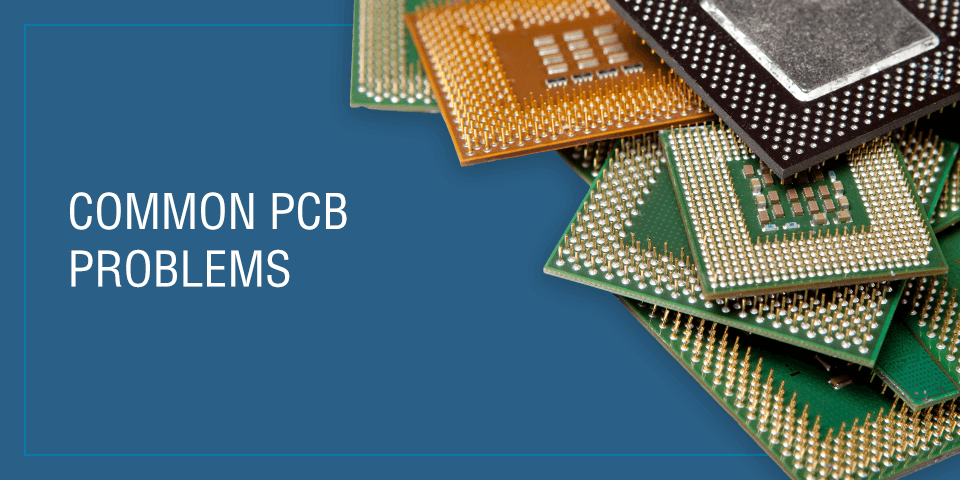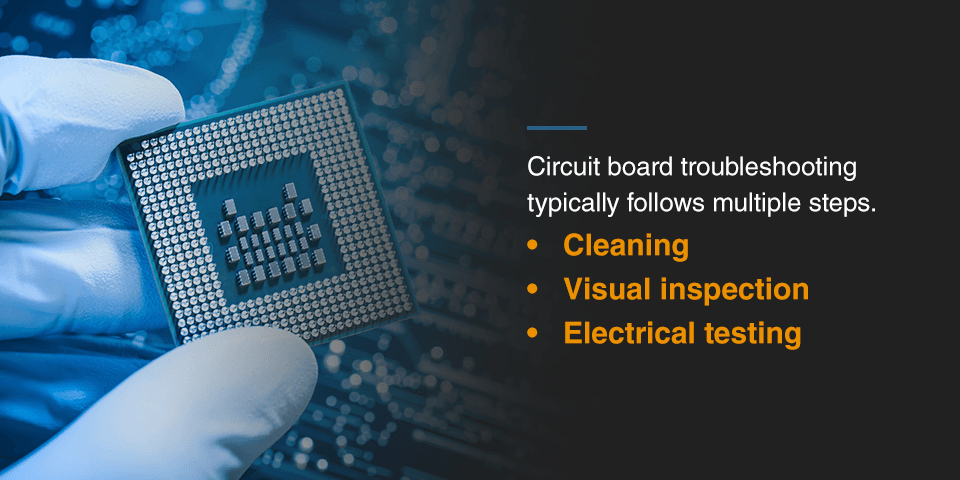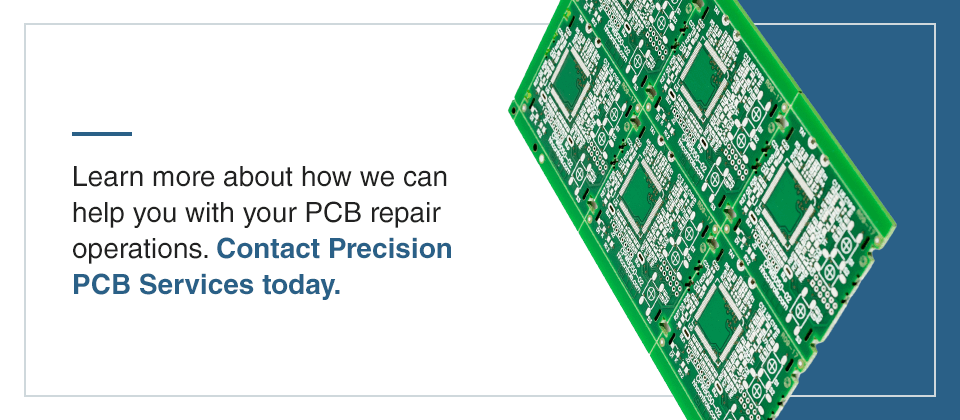Common PCB Problems

Printed circuit boards are the hidden backbone of modern technology, found in everything from laptops and phones to toys and LED displays. Manufacturers build PCBs with a broad range of techniques to meet the needs of each specification. However, accidents and errors happen — design and manufacturing flaws or accidental damage can result in PCB malfunctions.
Here, we will discuss some of the most common PCB problems, how to troubleshoot a circuit board and when and how to choose PCB repair services to bring circuit boards back into operation.
Common Reasons for PCB Failure
PCBs can be incredibly intricate and technically complex, packing several vital components into a tiny package. However, there are plenty of ways for printed circuit boards to fail.
Most printed circuit board problems come down to four primary sources.
- Physical damage: While PCBs are highly functional, they are also relatively fragile. Drops, impacts, heat damage and even exposure to water, dust or insects can all result in physical damage to the PCB or its components. A typical example is trace damage caused by physical wear or corrosion.
- Component failure: Components on circuit boards wear down with age, eventually malfunctioning or ceasing to work entirely. While some components may fail more quickly due to physical damage or poor design choices, component failures happen naturally over time.
- Manufacturing errors: Many manufacturing problems might slip through the cracks until late in the manufacturing process or even when the board goes into use. These are usually the result of mistakes during the soldering or reflow process, and include everything from poor soldering jobs to board and component misalignments.
- Design flaws: Finally, some design choices can also result in PCB malfunctions. At one estimate, 64% of avoidable PCB defects are the result of human error. These problems include incorrect placement of board components and traces and improper selection of materials for the application. All these issues can result in inadequate performance.
Printed circuit board problems will likely fall into one or more of these categories — quality troubleshooting processes will help determine which ones.

Troubleshooting PCBs
After realizing a PCB is having problems, the next question is how to troubleshoot the circuit board. Circuit board troubleshooting typically follows multiple steps.
- Cleaning: Before a PCB can undergo effective troubleshooting, it should be free of any debris. The specialist performing the troubleshooting should note the type of contaminants on the PCB, such as dust, mud and insects, as these can provide insights into the problem at hand.
- Visual inspection: Once the PCB is clean, the specialist will inspect it for obvious problems, such as swelling, charring, corrosion or cracks. These indicators can help diagnose some symptoms — for example, charring can indicate thermal regulation issues. During this step, the specialist will also look at the solder joints to identify solder issues like bridges or gaps.
- Electrical testing: If the previous steps don’t identify the problem, the specialist will use electrical testing to find the defect in the PCB. This process starts with measuring the power supply voltage to verify that it is the correct value, then follows up with detailed tests and measurements using troubleshooting equipment.
An experienced technician with the tools and training to perform quality troubleshooting services should complete these steps.
Should I Replace or Repair My PCB?
When PCBs and their components fail, many manufacturers choose to discard them, which has been a significant contributor to the 50 million tons of e-waste produced each year. Instead of automatically throwing away PCBs when they fail, manufacturers should instead weigh the pros and cons of replacing vs. repairing them.
Electronic devices can last for several years, and good electronic troubleshooting and repair services can extend this longevity. Refurbishing services restore PCBs to like-new condition, often saving manufacturers money compared to how much they would spend on a replacement PCB.
While circuit board repair services offer advantages over replacement, the reality is that repair is not always the best option. Here are three crucial factors to consider before deciding whether to replace or repair a PCB.
- Timing: If a PCB fails prematurely or during the manufacturing process, it is usually more economical to perform repairs instead of spending money on materials for a replacement.
- Quality: Inexpensive PCBs will usually be more expensive to fix than they are to replace. If the PCB and its components are lower-quality, it’s often not worth the labor involved for repairs. However, with a mid-range PCB, it’s worth your time to do a cost-benefit analysis to help you decide whether to repair or replace it.
- Extent: If troubleshooting identifies few or easy-to-fix problems, a repair is usually the better option over replacement. However, PCBs with extensive damage will typically be more expensive to fix than to replace.
If you decide repairing your PCB is the best option for your situation, you need to have the work done correctly. The best option is to have qualified in-house specialists or partner with a professional circuit board repair service with tools and knowledge you can trust.
What to Look for in Repair Services
Circuit board repair services offer an excellent alternative over replacement, especially for new, high-quality PCBs that require a few fixes. However, it is essential to choose a repair service that meets all your needs beyond basic troubleshooting and repair. Here are some critical qualities to look for in a circuit board repair service.
- Experience: Compare repair services’ track record for repair and replacement services and knowledge of a range of repair operations.
- Equipment: Quality repair services will have dedicated troubleshooting and repair equipment for quick and professional performance.
- Supply lines: The last thing you need is a repair service with slow supply lines for component replacement. Seek out services with dependable supply lines that can help guarantee quick turnarounds for repairs.
- Testing and reporting: Repair services should provide quality data to go along with their troubleshooting, showing documentation to support each conclusion and repair operation.
- Customer service: A customer-centric attitude is paramount. Look for repair services with dedicated customer support services, warranties and quality assurance policies.
In addition to these qualities, look for providers that offer the range of services your company needs. Troubleshooting and repair are only the tip of the iceberg — for the best results, look for repair companies that offer consulting and training to help you get the best results with your PCBs every time.
Choose Precision PCB Services
Repairing PCBs is an essential capability for manufacturers looking to cut costs and reduce e-waste. With quality PCB repair service, manufacturers can achieve quality repairs. If you’re looking for a service that offers troubleshooting, repair, and more, Precision PCB Services is here to help.
Precision PCB Services is an industry leader in PCB repair services with over 25 years of industry experience. We offer rework and repair services and consulting for electronics manufacturers. Our priority is helping our customers improve their products’ quality while reducing defects and waste, using repair operations to help turn scrap into working products.
If you want to achieve quality in-house rework and repair operations, Precision PCB Services has options for you. On top of our rework and repair services, we also offer high-end BGA rework stations and a range of training services. Our products come with lifetime technical support and our training and certification courses follow IPC guidelines.
Learn more about how we can help you with your PCB repair operations. Contact Precision PCB Services today.
